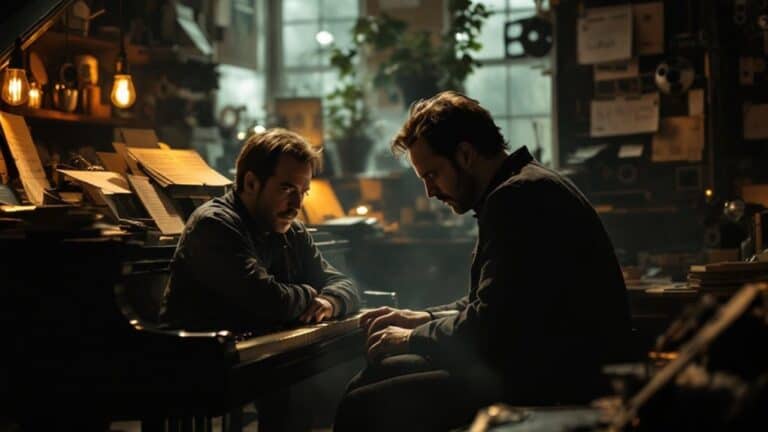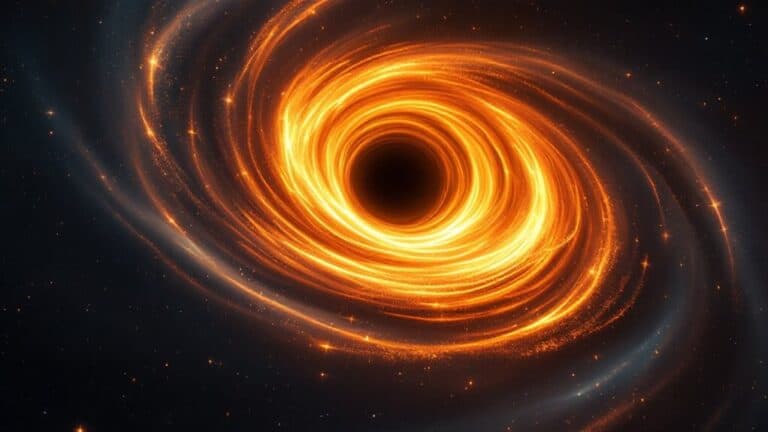Musical Themes in Interstellar: Decoding Zimmer’s Emotional Language
In *Interstellar*, Hans Zimmer utilizes innovative orchestration to evoke profound emotional themes, particularly around family bonds and sacrifice. The score features a prominent organ, which adds unique timbre while harmonically emphasizing moments of urgency through pedal points and dynamic crescendos. Zimmer intertwines love and loss within a haunting four-note ostinato, encapsulating the relationship between Cooper and Murph. As the music evolves, it mirrors their shifting emotional states, enhancing storytelling by grounding complex time structures and creating an immersive experience. This intricate layering invites you to reflect on the nuances of love, urging you to explore further insights found throughout the film’s powerful score.
Table of Contents
Key Takeaways
- The score’s four-note ostinato symbolizes the deep familial bond between Cooper and Murph, emphasizing themes of love and sacrifice.
- Unconventional orchestration, particularly the use of the Harrison & Harrison organ, adds unique timbre and emotional weight to the narrative.
- A blend of electronic elements and choral arrangements enhances the emotional landscape, inviting audience connection through haunting melodies.
- Urgency in the score mirrors the characters’ race against time, with musical phrasing reflecting pivotal narrative moments and emotional shifts.
- Minimalist techniques create tension and release, while maximalist emotions provide depth, enriching the film’s storytelling through sound.
Musical Structure and Techniques
While exploring the musical structure and techniques in *Interstellar*, you’ll find that the score intricately blends various elements to create a fascinating auditory experience. This masterpiece showcases Hans Zimmer‘s musical innovation, employing a stunning mix of orchestration and sound design. The prominent use of the 1926 Four-manual Harrison & Harrison organ adds a unique timbre, resonating deeply with the haunting themes of the film.
You’ll notice how the harmonic structure cleverly utilizes a pedal point, with the E note mimicking the relentless ticking of a clock, symbolizing urgency. Chord progressions like Gadd6 and Fmajor7 enhance the thematic development, creating rich layers of sound that invite exploration. The repetition of the four-note theme, transformed through various melodic techniques, allows you to feel different emotions as the story unfolds. Additionally, the score’s key signature of A natural minor contributes to its overall emotional landscape, enhancing the film’s intensity. The organ serves as a crucial element, providing texture and grandeur throughout the score. This innovative approach reflects Zimmer’s ability to convey the emotional core of love through music, reinforcing the film’s themes.
Moreover, the intricate layering of instruments, combined with sound effects like wooden blocks and time-stretched percussion, crafts a dense texture that echoes the vastness of space. Each element works harmoniously, inviting you to lose yourself in this sonic journey, where every note and pause resonates with the film’s profound narrative.
Emotional Core of the Score
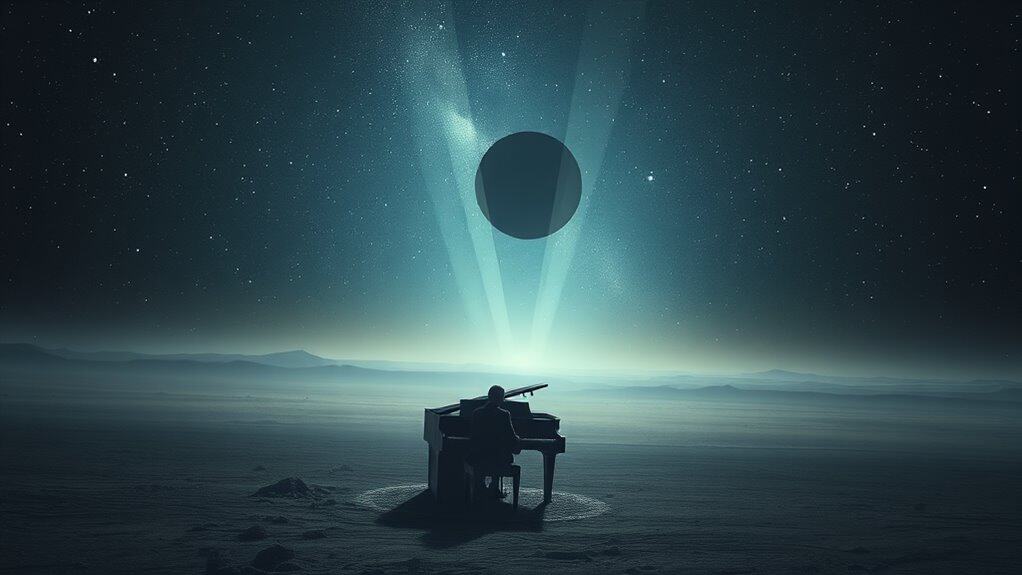
In “Interstellar,” the emotional core of the score beautifully explores the fragile yet profound bond between family members, particularly the connection between a father and daughter.
As you listen, you’ll notice how the music captures the vastness of space while simultaneously reflecting the deep emotional currents of love and loss that tether the characters to one another. The score, featuring a 1926 Harrison & Harrison organ, incorporates unique orchestration that enhances the film’s emotional themes. This emotional depth is amplified by the 60-person choir that adds richness and spirituality to the score, creating an atmosphere that diverges from typical sci-fi scores.
Familial Bond Exploration
The emotional core of Interstellar’s score revolves around the deep familial bond between Cooper and his daughter, Murph. This connection is underscored by Zimmer’s poignant musical themes, particularly the four-note ostinato that encapsulates their relationship. As you listen, you can feel the weight of familial sacrifice, where Cooper’s journey into the unknown reflects the emotional distance that grows between him and Murph. The music serves as a bridge, inviting you to explore their profound love amidst the vastness of space and time.
The score acts as an emotional glue, intertwining their narrative with haunting melodies that resonate with your own experiences of love and yearning. When the choir joins the orchestral arrangements, it deepens the emotional landscape, allowing you to feel the spiritual connection that transcends mere words. The rich orchestration, featuring a 60-voice mixed choir, enhances the depth of their relationship and amplifies the film’s emotional impact. Furthermore, the film’s cinematography and visual effects also play a crucial role in complementing the score, creating a fully immersive experience.
Each moment becomes a reminder of the complexities of family ties, where joy and sorrow coexist. Through Zimmer’s innovative instrumentation, you experience a rich tapestry of emotions that reflect not only the characters’ struggles but also your own longing for belonging. This exploration of familial bonds elevates the score, making it an essential element of the film’s storytelling.
Fragility and Vastness
Exploring the emotional depth of familial bonds naturally leads to the broader themes of fragility and vastness that permeate Interstellar’s score. You can feel the fragility themes echoing through the minimalist approach Zimmer employs, where repetition and simple motifs craft a soundscape that mirrors the vastness of space. This score doesn’t just highlight how small we’re compared to the cosmos; it emphasizes our deep emotional connections amid that overwhelming expanse. The organ plays an essential role, infusing the score with an emotive power that’s both unconventional and profound. In cues like “Imperfect Lock,” it punctuates moments of tension, bridging the gap between human experience and scientific exploration. Additionally, the score features a blend of orchestral and electronic elements, further enhancing its emotional landscape. The minimalist approach allows for a delicate balance between simplicity and complexity, creating a profound emotional resonance. This rhythmic breathing creates a sense of intimacy within the grand scale of the universe. As you listen, you’ll notice how the music’s structure reflects the film’s temporal complexities, guiding you through its emotional narrative.
Moreover, the collaboration with theoretical physicist Kip Thorne ensured that the score resonated with the scientific themes presented in the film. The minimalistic maximalism of the score resonates, reminding you of the delicate balance between love and loss. In this way, Zimmer beautifully captures the essence of our existence—fragile yet vast, intimate yet expansive—reminding you of the connections that truly matter.
Emotional Motifs Analysis
Musical motifs in Interstellar resonate deeply with the emotional journeys of its characters, particularly the poignant bond between Cooper and Murph. Hans Zimmer’s score expertly weaves musical symbolism into the narrative, creating emotional landscapes that reflect the characters’ experiences of love and loss. Central to these themes is the Cooper and Murph motif, which encapsulates their father-daughter connection, emphasizing the profound emotional stakes of their journey.
- The pipe organ’s rich tones evoke a sense of spiritual connection.
- Action themes double as familial love themes, highlighting their duality.
- Unique vocal techniques create a surreal atmosphere, enhancing emotional intensity.
- Sophisticated sound design, including reversed timpanis, adds depth and texture.
- Choral elements elevate the score, deepening its emotional resonance. The urgency of the score, particularly through the clock ticking sound, mirrors the characters’ race against time. Additionally, the ensemble’s size, which includes 34 strings and 24 woodwinds, contributes to the score’s grand and sweeping emotional landscape.
Through these elements, Zimmer crafts an immersive experience, drawing viewers into the characters’ emotional realities. The music doesn’t merely accompany the visuals; it amplifies them, reinforcing the human connection to the cosmos and situating personal emotions within the expansive narrative.
Ultimately, this emotional authenticity not only enhances storytelling but also invites you to reflect on your own relationships, making the experience profoundly relatable.
Instrumental Choices and Sound Design

Instrumental choices and sound design in *Interstellar* play an essential role in shaping the film’s emotional landscape. Hans Zimmer‘s instrumental innovation shines through the unconventional use of the organ, which becomes the score’s centerpiece. This choice not only sets a distinctive tone for a sci-fi film but also allows for a profound exploration of soundscapes that echo the vastness of space and the depths of human emotion.
You’ll notice how the organ shifts from soft, contemplative notes to powerful crescendos, mirroring the characters’ emotional journeys, particularly in pieces like *Cornfield Chase* and *Stay*.
The incorporation of gentle electronics enhances the organ’s solemnity, while string accompaniments amplify its emotional impact, creating a rich tapestry of sound. Through thematic variations, Zimmer keeps you emotionally engaged, as the organ’s motifs recur, reminding you of the characters’ struggles and hopes. This intricate sound design, which involves a mix of diegetic and non-diegetic sounds, crafts a cohesive narrative that draws you into the film’s universe. Additionally, the use of hybrid sound design techniques allows for the creation of expansive soundscapes, enhancing the overall auditory experience.
In addition, the sound design cleverly integrates diegetic and non-diegetic sounds, crafting a cohesive narrative that draws you into the film’s universe. This seamless blend of instrumental choices and soundscapes exploration guarantees you feel the weight of every moment, making *Interstellar* an unforgettable auditory experience.
Temporal and Narrative Functions
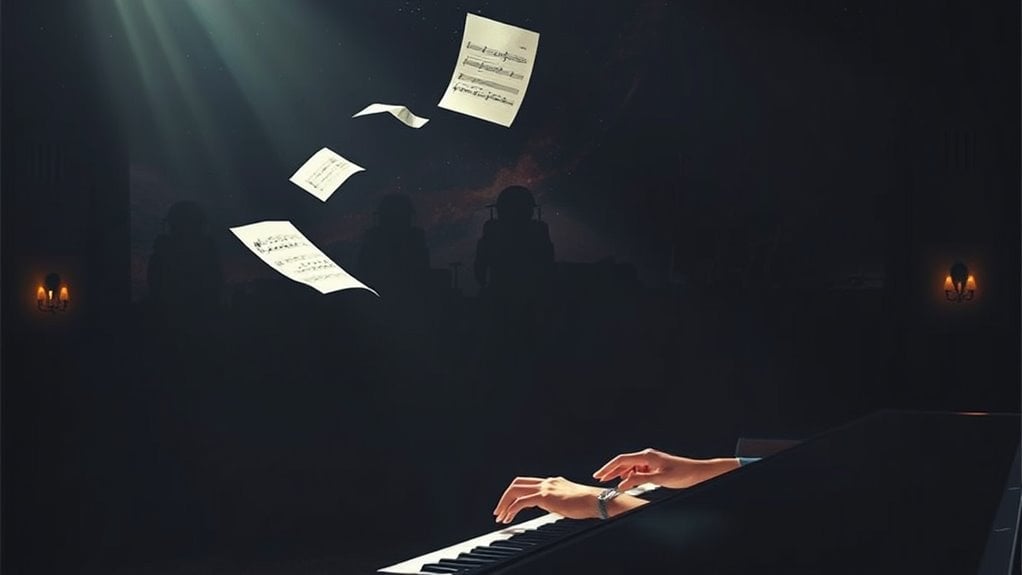
Utilizing music as a temporal anchor, *Interstellar* intricately weaves sound into its narrative fabric, guiding you through the film’s complex time structure. The score isn’t just background; it shapes your understanding of temporal shifts and enhances narrative clarity.
You’ll notice how the ticking clock motif evokes urgency, while musical phrasing and tempo changes signal pivotal moments in time.
- The layering of themes creates a multi-temporal experience.
- Silence amplifies significant time jumps.
- Specific motifs help you navigate the narrative’s complexity.
- Dynamics control tension and release, influencing pacing.
- Arpeggios underscore moments of temporal tension.
Themes of Familial Bonds

In “Interstellar,” the father-daughter connection between Cooper and Murph serves as a powerful emotional anchor throughout the film.
You can hear this bond reflected in Hans Zimmer’s score, where the music resonates with both love and the isolation they face, creating a poignant backdrop for their journey.
As you explore these themes, consider how their relationship evolves amidst the vastness of space and time, highlighting the enduring nature of familial love.
Father-Daughter Connection
The father-daughter connection in “Interstellar” serves as a powerful emotional anchor, driving the narrative through a tapestry of love and sacrifice. This relationship encapsulates the father-daughter dynamics, revealing profound emotional symbolism that resonates throughout the film.
As you immerse yourself in their story, the music plays a pivotal role in expressing their bond.
- The love theme transcends space and time, embodying their unbreakable connection.
- Variations in Zimmer’s score mirror the characters’ shifting emotional states, emphasizing their struggles and triumphs.
- The integration of music with scientific themes highlights their shared endeavors, deepening the connection.
- Changes in tempo and mood reflect the complexities of their relationship, capturing moments of joy and pain.
- The theme illustrates their cross-dimensional communication, showcasing how love can bridge vast distances.
Emotional Resonance in Score
Music in *Interstellar* resonates deeply with the themes of familial bonds, transforming emotional moments into unforgettable experiences. Hans Zimmer’s score acts as emotional glue, weaving connections between the characters and their journeys. The thematic cohesion is palpable; the main theme, rooted in the father-son relationship, emphasizes the profound love that transcends space and time. As you listen, you’ll notice how the haunting melodies evoke feelings of tenderness, drawing you closer to Cooper and Murph’s struggle.
The interplay between voice and instrument creates an immersive experience, inviting you to not just hear but to truly feel the characters’ emotions. With its simpler melodies, the score captures emotional depth, making poignant moments even more impactful. Each crescendo reflects the grandeur of their connection, while softer themes convey the complexities of love and longing.
Zimmer spent years crafting this score, ensuring that it would resonate with your heart as much as your mind. The music doesn’t merely accompany the visuals; it elevates them, creating a cosmic symphony that speaks to the essence of family.
In this way, the score becomes a crucial part of the narrative, echoing the importance of belonging amidst the vastness of the universe.
Love Amidst Isolation
Themes of love amidst isolation permeate *Interstellar*, revealing how the film prioritizes familial bonds over its grand narrative of space exploration. The father-daughter relationship between Cooper and Murph stands at the heart of the story, stretching across time and dimensions, emphasizing that love can transcend even the most profound isolation themes. Zimmer’s evocative score deepens this connection, framing their emotional journey with haunting melodies that resonate in your heart.
- The film opens and closes with family scenes, underscoring their importance.
- Cooper’s sacrifices for Murph highlight the emotional depth of parental love.
- Conversations about “coming home” reinforce the significance of family ties.
- Key musical pieces, like “Cornfield Chase,” evoke longing and innocence.
- The final reunion, paired with Zimmer’s crescendo, encapsulates the film’s emotional core.
As you explore the love exploration in Interstellar, you realize that the film’s true message lies in the sacredness of family bonds, reminding you of your own connections.
The emotional landscape constructed through familial themes makes the narrative not just memorable, but profoundly relatable, inviting you to reflect on your own relationships amidst life’s inevitable separations.
Minimalism and Maximalism

While exploring the score of *Interstellar*, you’ll notice a fascinating interplay between minimalism and maximalism that shapes the film’s emotional landscape. Zimmer employs minimalist techniques, like light orchestration and simple, repetitive themes, to evoke feelings of fragility and patience. This understated approach mirrors the vastness of space, creating a sense of isolation while inviting you into the emotional core of the narrative.
| Minimalism Techniques | Maximalism Emotions | Examples in *Interstellar* |
|---|---|---|
| Light orchestration | Complex emotional depth | Sparse strings in key moments |
| Simple, repetitive themes | Heightened drama | Recurrent motifs during climaxes |
| Cell and motif structure | Rich narrative layers | Themes intertwining across timelines |
| Non-traditional instrumentation | Grand emotional arcs | Unique sounds enhancing the journey |
This “minimalistic maximalism” allows the score to serve multiple narrative functions, guiding you through complex temporalities while infusing the film with layered emotional resonance. As you listen, you’ll find that the combination of minimalist techniques and maximalist emotions creates an unforgettable experience, drawing you deeper into the story’s heart and inviting you to contemplate its profound themes.
Collaborations With Christopher Nolan

The collaboration between Hans Zimmer and Christopher Nolan has profoundly shaped modern film scoring, beginning with *Batman Begins* in 2005. This partnership marked a collaborative evolution that led to a series of iconic scores, each pushing the boundaries of cinematic music.
- Each score redefined character emotions, such as the bold brass of Batman Begins.
- The haunting single note for the Joker in The Dark Knight became unforgettable.
- *Inception* introduced the “BRAAAM,” a cue that revolutionized film marketing.
- *Interstellar* featured a simple four-note theme that echoed the characters’ emotional journeys.
- *Dunkirk* utilized the Shepard tone, showcasing Zimmer’s innovative techniques.
Together, Zimmer and Nolan emphasized that sound design is as essential as visuals, creating an immersive experience for audiences.
Their creative processes often involved simple yet powerful themes, allowing complex emotions to resonate deeply.
Even after Zimmer chose to work on *Dune* instead of *Tenet*, their mutual respect remained intact.
This collaboration not only enriched the films but also forged a unique bond that invites audiences to connect on a profound level, reminding us that music can be as significant as the stories themselves.
Cultural and Historical Context
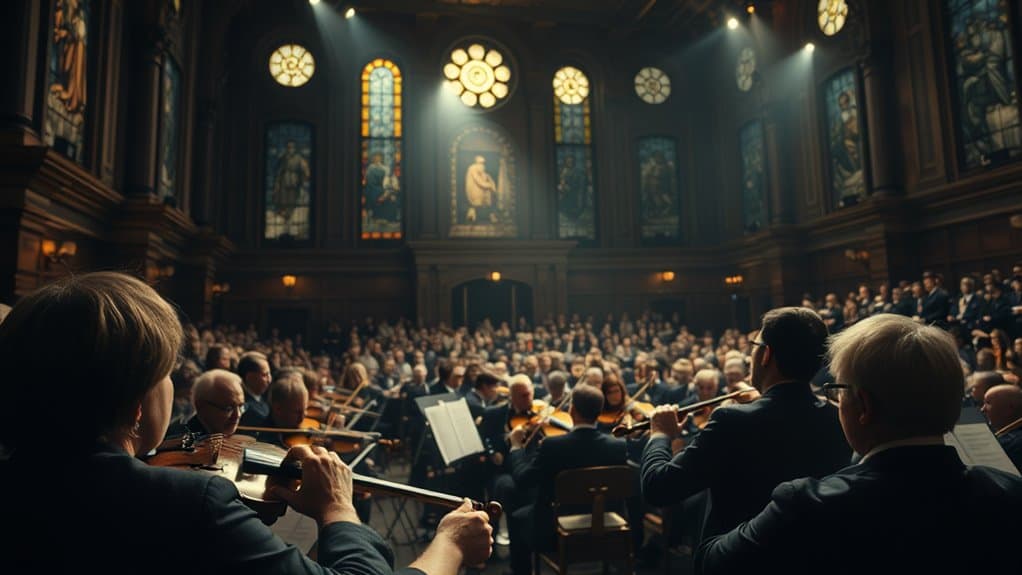
Exploring the cultural and historical context of *Interstellar* reveals how the film reflects a uniquely American perspective on the past and future. This cinematic journey draws on historical influences, presenting a nation grappling with the Blight, a haunting reminder of environmental collapse.
You can see echoes of nostalgia for a powerful America, reminiscent of films like *Edge of Tomorrow*, while the American flag flying on distant planets symbolizes hope and triumph.
However, *Interstellar* also critiques governmental secrecy, particularly regarding the Lazarus missions, urging you to question established narratives. It contrasts with other science fiction films, like *Star Trek*, suggesting that nationalism is a relic of the past.
Throughout, the film pays homage to significant works, including Orwell’s *1984* and Dylan Thomas’s poignant poem, encouraging you to reflect deeply on human nature and societal values.
Ultimately, *Interstellar* prompts you to look to the past to make sense of the present and future, underscoring the importance of historical understanding.
Visual and Aesthetic Correlation
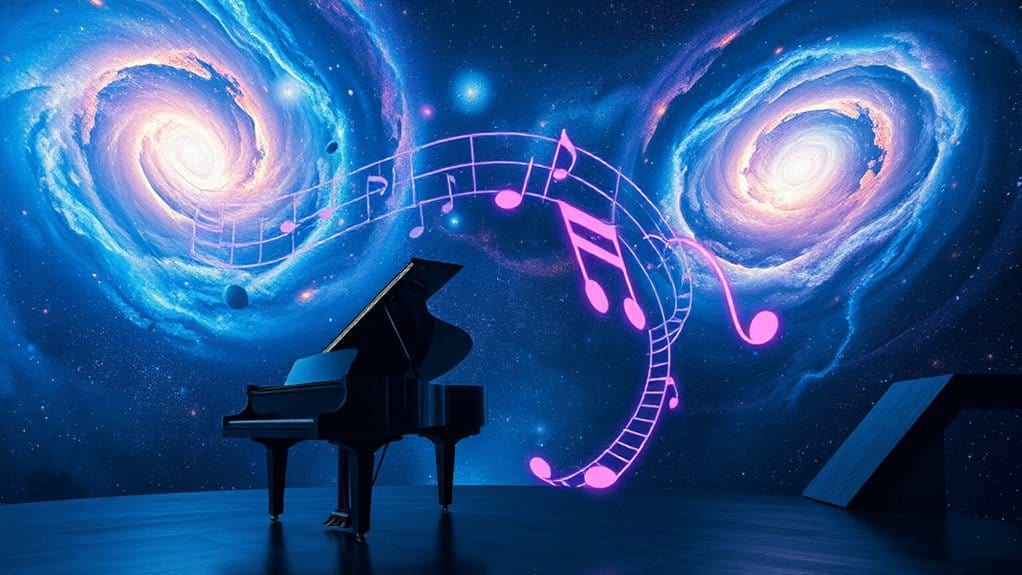
Creating a seamless visual and auditory experience, *Interstellar* masterfully intertwines its score with the film’s overarching themes of time, isolation, and human connection. The auditory landscape enriches the visual symbolism, transforming each scene into an emotional journey.
You’ll notice how the minimalist score mirrors the film’s poignant themes, emphasizing love as an essential connection amid the vast cosmos.
- The ticking clock sound immerses you in the relentless passage of time.
- The London Temple Church organ adds an ethereal quality, evoking mysticism.
- The four-note theme evolves, reflecting characters’ emotional states.
- Pedal points and repetitive notes enhance the feeling of space and time.
- The interplay between voice and instrument creates profound emotional depth.
This unique approach, eschewing grandiosity for intimacy, resonates deeply, making you feel every heartbeat in the narrative.
As you watch, the music doesn’t merely accompany the visuals; it breathes life into them, elevating the storytelling to new heights. The score’s emotional resonance guides you through an interstellar journey, ultimately reminding you of the essential human connections that bind us, even across the vastness of space.
Critical Reception and Impact

When you listen to the score of “Interstellar,” you can’t help but feel its profound emotional weight, which resonates deeply with audiences.
The recognition from prestigious awards, like the Academy Award and Grammy nominations, highlights how critics appreciate its innovative composition and powerful impact.
This soundtrack not only enhances the film’s narrative but also sets a new standard for emotional storytelling in cinema, making it a memorable part of the movie experience.
Audience Emotional Response
Critics frequently praise the emotional depth of the score in *Interstellar*, noting how it profoundly impacts the audience’s experience. The music weaves an intricate tapestry of sound that fosters profound audience immersion and emotional connection, making the film not just a visual spectacle but a deeply felt journey.
- The pipe organ evokes awe, highlighting the vastness of space.
- Rhythmic compositions convey shifts in time perception, enhancing tension.
- A repeated theme creates thematic cohesion, linking character motivations.
- The score’s innovative orchestration draws you into the narrative’s emotional core.
- Critics laud its ability to act as a perceptual guide, voicing unexpressed feelings.
This emotional resonance serves as an effective glue, binding together various events and character arcs within the film. As you listen, the music resonates with your own experiences, creating a shared emotional landscape that invites you to explore your feelings.
Each note amplifies the film’s themes, inviting you to reflect on love, sacrifice, and the human condition. Ultimately, Zimmer’s score doesn’t just accompany the visuals; it elevates them, allowing you to feel a part of something bigger and more profound than yourself.
Awards and Recognitions
The score of *Interstellar* has garnered significant acclaim, reflecting its profound impact on both audiences and critics alike. Nominated for an Academy Award for Best Original Score and a Grammy, Zimmer’s work is celebrated for its colossal, reverberating pipe-organ chords, as highlighted by *BBC News*. Critics from *Variety* and *The Telegraph* have praised its inventive nature and hypnotic homage to *Koyaanisqatsi*, respectively.
With an impressive 44 awards and 148 nominations, the score’s significance is clear, marking a remarkable legacy within film music. Zimmer’s themes, designed to evoke emotional states rather than just focus on characters, create a unique listening experience.
The score’s experimental approach and powerful orchestration choices, commended by *The Miami Herald* and *Movie Music UK*, enhance the film’s narrative depth. This enduring influence is evident as others may attempt to replicate its style, but its originality remains unmatched.
Critics agree that the score not only fits the film’s vast dimensions but also elevates its emotional journey, ensuring that its impact will resonate for years to come. In this way, *Interstellar* solidifies Zimmer’s reputation as a master composer, creating a collective experience that unites listeners across different backgrounds.
Conclusion
In “Interstellar,” Hans Zimmer crafts a score that transcends mere sound, plunging you into an emotional abyss where time and space intertwine. Each note resonates with the gravity of familial bonds and existential longing, echoing the film’s profound themes. The instrumental choices, masterfully intertwined with Nolan’s vision, elevate the narrative to celestial heights. As you reflect on this auditory journey, it becomes clear that Zimmer’s music is not just a backdrop but the very heartbeat of the film itself.



